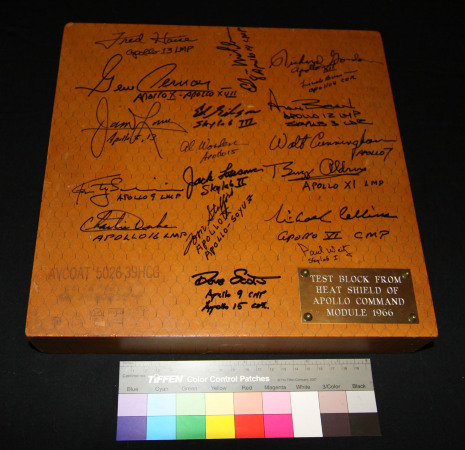Artifact: Ablative Heatshield Test Block, Apollo Command Module, Block II
Fiberglass honeycomb filled with epoxy-novalac resin; reinforced with quartz fibers and phenolic microballons
An AVCOAT 5026-39HCG Heatshield block (1 square foot/12x12inch; 2 inch thick) manufactured in 1966 as a component of the Command Service Module (CSM) Thermal Protection System). The artifact bears the signatures of 17 Apollo and Skylab astronauts who flew onboard the Command Module.
AVCOAT was produced by AVCO corporation, with integration into the Command Module's Thermal Protection System (TPS) by NAA (North American Aviation). The block is comprised of an extremely lightweight fiberglass honeycomb filled with an epoxy-novalac resin reinforced with quartz fibers and phenolic microballons. Command Module installation required application of the material into a honeycomb matrix (comprised of 3/8 inch diameter individual cells) that has been previously vacuum bonded to a stainless-steel substructure which in turn was braze welded to the Heat Shield subassemblies. The AVCOAT 5026-39HCG compound was applied to the individual honeycomb cells with a dielectrically heated (160 degree F.) hypodermic device similar to a caulking gun (the operation was termed "gunning"). After completion of filling, the subassemblies were vacuum bagged and the ablator oven cured for 16 hours at 200 degrees F, machined on a turret lathe to the design-thickness and x-rayed to detect any defects. Thickness of the TPS ablator ranged from .7 to 2.7 inches and varied with the projected local environment on the spacecraft's Aft, Crew Compartment and Forward headshields (a function of the re-entering Command Module's attitude with respect to the atmosphere).
The unflown example in this collection has 1,024 individual hand filled cells; the completed CSM heatshield had 370,000 cells. The ablative characteristic (i.e. the material essentially melts and chars away during re-entry) mitigates the 20,000 degree heat experienced by the CSM as it transits through the extreme thermo-dynamic phase of the re-entry corridor.
This artifact bears the signatures of many of the crew who flew onboard the Apollo spacecraft to include:
- Apollo 7: Walter Cunningham
- Apollo 8: Frank Borman, Jim Lovell
- Apollo 9: Rusty Schweickart, Dave Scott
- Apollo 10: Tom Stafford, Gene Cernan
- Apollo 11: Buzz Aldrin, Michael Collins
- Apollo 12: Richard Gordon, Alan Bean
- Apollo 13: Fred Haise, Jim Lovell
- Apollo 14: Edgar Mitchell
- Apollo 15: David Scott, Al Worden
- Apollo 16: Charlie Duke
- Apollo 17: Gene Cernan
- Skylab I: Paul Weitz
- Skylab II: Jack Lousma, Alan Bean
- Skylab III: Ed Gibson
- Apollo-Soyuz: Tom Stafford

